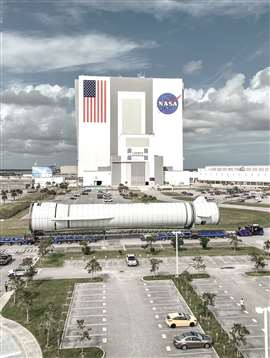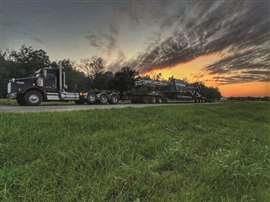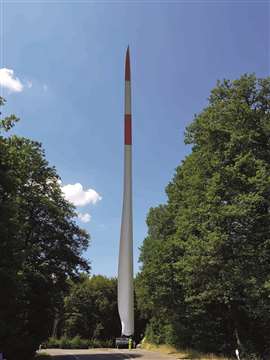Heavy haul trailer innovations fuel renewable energy and construction growth
09 December 2024
From solid to thriving to robust, that’s how heavy haul trailer manufacturers describe the U.S. market for their products.
 A Nelson Manufacturing West Coast 9-axle trailer with a well deck section was designed to transport mobile boilers.
A Nelson Manufacturing West Coast 9-axle trailer with a well deck section was designed to transport mobile boilers.
“We provide heavy haul trailers for many niche markets, and many of these areas remain very busy,” said Tony Niese, president of Nelson Manufacturing. “These markets include transformers, mobile sub-stations, aerospace and crane boom launch trailers.”
Nelson customers want lighter trailers so that they can haul more weight.
“The empty weight of the trailer seems to be the biggest concern,” Niese said. “Customers are also concerned with maneuverability and reliability.”
Nelson’s niche in the trailer market is customized solutions.
“We work with various entities to provide trailers for mobile transformers, mobile sub-stations, mobile boilers, aircraft components, commercial launch vehicle components and even satellites,” Niese said. “Since we offer custom solutions, we do not simply have three or four models to choose from. We offer complete design, engineering, manufacturing and thorough testing of our products.”
 Trail King’s TKEFX is a popular blade hauler.
Trail King’s TKEFX is a popular blade hauler.
Nelson deals with many heavy, large and/or sensitive cargos that require substantial engineering analysis.
“We offer shock isolation systems for extremely sensitive payloads,” Niese said. “One of our more popular features that customers are looking for are enhanced maneuverability through manual hydraulic steering and automatic steering trailers. Additionally, having a trailer that can haul large payloads but then be easily reconfigured for a more compact version for empty travel has become increasingly important.”
Most supply chain issues have improved, Niese said, but there are still long lead times for certain hydraulic and electronic components.”
Ty Hanten, vice president of sales and marketing for Trail King, said the heavy haul trailer market is thriving.
“With consistent demand and steady activity, it’s an exciting time,” he said.
Trail King’s heavy haul customers are looking for four key elements, including functionality, reliability, versatility and weight efficiency, Hanten said.
Trail King’s Schnable system is its best-selling trailer system.
U.S. expansion
Luxembourg, Belgium-based Faymonville recently announced it will open its first production facility in the United States in Little Rock, AR. This new venture will expand the company’s footprint and strengthen its North American position. Located on a 54-acre site at the Port of Little Rock, the initial facility will encompass 409,000 square feet. A planned second phase will add 624,000 square feet.
 Rossco Crane & Rigging uses its Faymonville HighwayMax to haul a rough terrain crane.
Rossco Crane & Rigging uses its Faymonville HighwayMax to haul a rough terrain crane.
Faymonville’s $100 million investment is expected to create some 500 new jobs and generate a significant economic boost.
With a product portfolio that includes Max Trailer, Faymonville and Cometto brands, the company specializes in semi-trailers, low-loaders, modular vehicles and self-propelled trailers. Faymonville produces around 3,000 transport units each year, delivering them to 125 countries and generating $500 million in revenue in 2023.
In Little Rock, Faymonville plans to initially manufacture individual components. Full production is anticipated by early 2026. The facility will also house expanded service and spare parts support for Cometto-branded vehicles.
Faymonville’s Thomas Blaise said that the U.S. market for its products is constantly growing.
“We developed over the last year a wide range of single-drop, double-drop, modular and flatbed trailers that meet the specific requirement of the U.S. market,” he said. “Our customers want sophisticated trailer solutions that are quick, operational and helpful for their different daily missions.”
Several industries have a growing demand for new trailers, including heavy and industrial transport, the oil and gas industry, construction, energy, cranes, wind power and finished parts, he said.
“We have a powerful partner, Hale Trailer, which has a huge network that distributes our products in the U.S. and ensures a quick after-sales service and spare parts delivery,” Blaise said.
Faymonville’s HighwayMAX is its best-selling trailer.
“Besides the classic 9-axle version, there are now some new applications with a 3-axle nitro-booster (HighwayMAX Booster), a 3-axle dolly and a 3-axle booster (HighwayMAX Dolly&Booster) or as a modular concept that can be combined as 3+6 axle double drop or 9-axle single-drop (HighwayMAX All-In-One),” Blaise said.
Infrastructure investment
TII’s Roland Fischer said the heavy haul trailer market in the U.S. remains dynamic and is currently shaped by global supply chain developments, large-scale infrastructure investments and increasing demand from the energy, construction and mining sectors.
 The TII Scheuerle client Blue Origin uses its HighwayGiant for a project at NASA.
The TII Scheuerle client Blue Origin uses its HighwayGiant for a project at NASA.
“The Infrastructure Investment and Jobs Act is a key driver for growth, with significant projects focused on modernizing roads, bridges and expanding renewable energy initiatives,” said Fischer. “Additionally, the market is influenced by changing regulations and a growing focus on sustainability.”
TII clients prioritize versatility, reliability and compliance with local regulations,” he added.
“They need trailers capable of handling increasingly heavy and oversized loads, with flexibility to adapt to diverse transport conditions across state lines, where regulations can vary significantly,” he said.
The leading industries include energy (especially wind, oil and gas), construction, mining as well as the aerospace industry, with significant influence from large-scale infrastructure projects, Fischer said.
“Our trailers stand out in the U.S. market due to their high-quality engineering and focus on customization,” Fischer explained. “TII Scheuerle has decades of experience with modular trailer systems, such as the SPMT and InterCombi/K25 families, which are globally recognized for versatility and load-bearing capacity. Additionally, we focus on compliance with local regulations, such as weight limits and emissions standards.”
Among TII’s bestselling models in North America are the InterCombi / K25 Modular Platform Trailers, which are highly flexible and robust, capable of transporting a wide range of heavy cargo in the 10.3-meter trailer range, he said.
“The InterCombi’s and K25’s popularity are rooted in adaptability and customization options, which are critical for U.S. customers dealing with diverse transport needs,” he said.
Skilled labor continues to be a problem for heavy haul companies.
“We see a shortage of skilled personnel to operate and service this often highly technical equipment, a challenge that is, in fact, global,” said Fischer. “Aging infrastructure, particularly bridges, presents additional obstacles. Innovative ideas and systems are essential to address these issues.”
Strong demand
The demand for heavy-haul trailers in 2024 mirrors what the market saw prior to the Covid pandemic, without the expected downturn going into the new year, according to Talbert Manufacturing’s Troy Geisler.
 Demand for trailers in 2024 has been solid for Talbert Manufacturing.
Demand for trailers in 2024 has been solid for Talbert Manufacturing.
“Usually, we see a dip in trailer sales during the fourth quarter, which hasn’t happened yet,” he said. “We’ve been blessed with opportunities in construction, infrastructure and heavy haul through the end of the year and into the beginning of next year. We are uncertain at this time how the markets will compare as we look into 2025.”
Talbert customers value safety and the option to customize their trailer to their application. Safety and dependability are Talbert’s biggest priorities.
Talbert has more than 85 years of experience in the heavy-haul trailer industry. Its bestselling trailer is the removable gooseneck trailer patented by Austin Talbert in 1947.
“The design addressed the high number of injuries and deaths that occurred during loading and unloading trailers with fixed necks,” Giesler said. “Today, the non-ground bearing gooseneck trailers use hydraulics to lift the trailer bed to connect or disconnect from the neck. [They are] more versatile than their ground-bearing counterparts with more ride height adjustment, a narrower neck and the ability to connect and disconnect on uneven surfaces.”
Robust demand
Goldhofer is experiencing robust growth and technological advancements – improved fuel efficiency, enhanced safety features and the integration of autonomous and electric capabilities – are shaping the market, according to Florian Bischofberger. A push for more sustainable transportation solutions is further stimulating demand. Despite challenges like high initial costs and stringent regulatory requirements, the market is poised for continued expansion and innovation, Bischofberger said.
“Clients in the heavy haul trailer market seek durability, versatility and ease of loading and unloading,” he said. “They also prioritize compliance with regulations and they are increasingly interested in technological advancements.”
The bestselling Goldhofer trailer in the U.S. is the THP/SL heavy duty module family.
While supply chain issues have improved, challenges persist.
“Material shortages continue to affect production,” he said. “Logistical bottlenecks and high transportation costs are still impacting the market.”
Other challenge are stringent regulatory compliance and the slow adoption of new technologies due to high costs.
“Despite these hurdles, the market continues to grow, driven by demand across various sectors,” Bischofberger concluded.
Emerging wind market
Trailer OEMs are anticipating that the wind market will continue to gain steam.
 Goldhofer’s blade transport system is designed for challenging terrains.
Goldhofer’s blade transport system is designed for challenging terrains.
“The market for hauling wind components is experiencing significant growth, particularly as wind farms increase in size and complexity, both onshore and offshore,” said TII’s Roland Fischer. “Wind turbine components are getting larger, requiring advanced trailers that can navigate challenging terrain and tight urban infrastructure.”
TII’s Rotor Blade Transport System (RBTS), the BladeLifter and SPMTs are geared towards the wind industry. In the offshore wind sector, TII offers the SPMT PowerHoss.
“The wind power sector is a whirlwind of opportunity, but it’s not without its challenges,” said Trail King’s Ty Hanten. “The market has become increasingly volatile, heavily influenced by government subsidies. As policy shifts, so does the landscape for innovation and sustainability.” Trail King’s TKEFX, Schnable and heavy haul trailers apply to the wind market.
Faymonville is also a big player in the wind market. The company’s flatbed range with up to four extensions is popular in the wind market, and its Cometto blade lifter raises up the blades.
“Despite logistical challenges such as trucking routes and permit applications, the market is expected to continue expanding, with significant investments in infrastructure and technology to support efficient transportation,” said Goldhofer’s Florian Bischofberger.
Goldhofer’s variable low-loader trailers and heavy-duty module combinations are often utilized in the wind industry.

